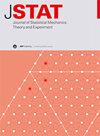马尔可夫跳跃过程速度极限不等式中的瓦瑟斯坦距离
IF 1.9
3区 物理与天体物理
Q2 MECHANICS
Journal of Statistical Mechanics: Theory and Experiment
Pub Date : 2024-07-18
DOI:10.1088/1742-5468/ad5438
引用次数: 0
摘要
研究了瓦瑟斯坦距离在马尔可夫跃迁过程的热力学速度极限不等式中的作用。我们从三个不同的角度阐明了热力学速度极限不等式中瓦瑟斯坦距离的性质,解决了三个遗留问题。首先,我们推导出了一般加权图的统一速度极限不等式,它既重现了传统的速度极限不等式,又重现了电流与熵产生之间的权衡关系作为其特例。其次,我们讨论了尚未获得瓦瑟斯坦距离最严格约束的情况,并研究了为何无法获得这样的约束。第三,我们比较了用 L1-Wasserstein 距离计算马尔可夫跃迁过程的速度极限不等式和用 L2-Wasserstein 距离计算过阻尼 Langevin 系统的速度极限不等式,并认为这两种不等式虽然表面上相似,但却有着不同的起源。本文章由计算机程序翻译,如有差异,请以英文原文为准。
Wasserstein distance in speed limit inequalities for Markov jump processes
The role of the Wasserstein distance in the thermodynamic speed limit inequalities for Markov jump processes is investigated. We elucidate the nature of the Wasserstein distance in the thermodynamic speed limit inequality from three different perspectives by resolving three remaining problems. First, we derive a unified speed limit inequality for a general weighted graph, which reproduces both the conventional speed limit inequality and the trade-off relation between current and entropy production as its special case. Second, we treat the setting where the tightest bound with the Wasserstein distance has not yet been obtained and investigate why such a bound is out of reach. Third, we compare the speed limit inequalities for Markov jump processes with the L1-Wasserstein distance and for overdamped Langevin systems with the L2-Wasserstein distance, and argue that these two have different origins, despite their apparent similarity.
求助全文
通过发布文献求助,成功后即可免费获取论文全文。
去求助
来源期刊
CiteScore
4.50
自引率
12.50%
发文量
210
审稿时长
1.0 months
期刊介绍:
JSTAT is targeted to a broad community interested in different aspects of statistical physics, which are roughly defined by the fields represented in the conferences called ''Statistical Physics''. Submissions from experimentalists working on all the topics which have some ''connection to statistical physics are also strongly encouraged.
The journal covers different topics which correspond to the following keyword sections.
1. Quantum statistical physics, condensed matter, integrable systems
Scientific Directors: Eduardo Fradkin and Giuseppe Mussardo
2. Classical statistical mechanics, equilibrium and non-equilibrium
Scientific Directors: David Mukamel, Matteo Marsili and Giuseppe Mussardo
3. Disordered systems, classical and quantum
Scientific Directors: Eduardo Fradkin and Riccardo Zecchina
4. Interdisciplinary statistical mechanics
Scientific Directors: Matteo Marsili and Riccardo Zecchina
5. Biological modelling and information
Scientific Directors: Matteo Marsili, William Bialek and Riccardo Zecchina

 求助内容:
求助内容: 应助结果提醒方式:
应助结果提醒方式:


